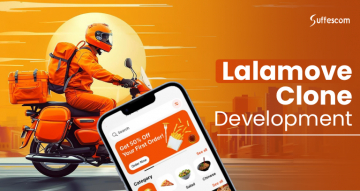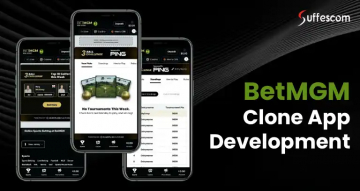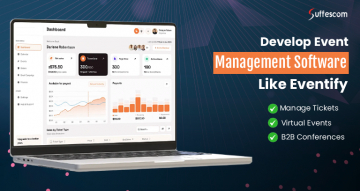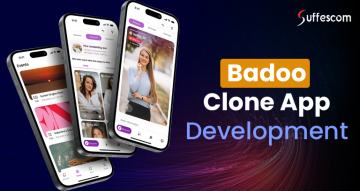Zynga Clone | Develop Poker Game App Like Zynga

Online gambling has experienced a significant increase in popularity, with user engagement growing across global markets. The transition from traditional, physical poker venues to digital platforms has fundamentally reshaped the gaming landscape. Players now access games remotely, leveraging advancements in online infrastructure and user interface design.
According to a report by Research and Markets, the global online poker market was valued at approximately USD 5.3 billion in 2024 and is projected to reach USD 11.4 billion by 2030, growing at a CAGR of 13.7% from 2024 to 2030.
For B2B businesses, it's crucial to understand the core structure of Zynga Poker clones, including the features they offer, reasons to choose them, and how they support business growth and scale up. Knowing these details is key to launching successfully and maintaining a strong position in the online poker industry over time.
Note - This Post is only for App and Software Development
We are an IT company, offering casino or gambling app and software development services only.
Appealing Reasons to Invest in Zynga Poker Clone
Accelerated Market Deployment
Developing an online poker platform from the ground up demands significant time and investment. Utilizing a pre-built clone solution expedites launch timelines, allowing rapid market entry and minimizing development cycles.
Extensive Customization Capabilities
A Zynga Poker Clone isn't rigid—it offers robust customization. You can adapt UI/UX elements, tweak gameplay logic, and integrate your unique branding, ensuring alignment with your company's strategic objectives and user expectations.
Scalable Architecture
These clone solutions are engineered for scalability. As concurrent player numbers surge, the system efficiently manages increased loads, maintaining optimal performance and stability during peak usage.
Multiple Monetization Channels
Leverage diverse revenue mechanisms: implement in-app purchases, charge tournament entry fees, serve targeted advertisements, or introduce premium subscriptions. The platform supports various monetization strategies to maximize ROI.
Enhanced User Engagement
Advanced social features and competitive gameplay loops drive sustained user activity. As a result, poker clones typically deliver superior retention and customer lifetime value compared to less interactive game genres.
Create Splendid Social Poker Game App Like Zynga
Accountable Features of a Zynga Like Poker Clone: Every Entrepreneur Must Know
User-Side Features
1. Multiplayer Infrastructure
Let's get one thing straight: the backbone of any poker app is robust multiplayer support. You need rock-solid servers to manage real-time matchmaking and live player interactions—no lag, no downtime, no excuses. Scalability is crucial here, especially during peak usage when everyone logs on simultaneously. If your backend can't handle a rush, you're in trouble.
2. Functional UI/UX
A clean, intuitive user interface is non-negotiable. Design navigation to enable users to access every feature quickly, regardless of whether they're on mobile or desktop. Responsive layouts, precise controls, and logical menus reduce user friction and let players focus on gameplay, not on searching for the "Fold" button. Consistency across platforms is a must.
3. Secure Transaction Systems
Payment integration demands bulletproof security. Support trusted gateways—Stripe, PayPal, plus any relevant local options—and make sure transactions are encrypted end-to-end. Compliance with industry standards, such as PCI DSS, isn't just a box to check; it's essential for maintaining user trust and generating ongoing revenue.
4. Real-Time Communication
Integrate chat systems capable of supporting real-time text, emojis, and optionally, voice communication. The architecture should prioritize low latency and reliable message delivery, all while maintaining a secure environment to prevent abuse or spam. Social features drive community engagement, which, in turn, increases retention.
5. Leaderboards & Incentive Structures
Implement global and friend-based leaderboards with dynamic updates to reflect ongoing gameplay. Reward systems—such as badges, ranks, and daily missions—should be directly tied to user achievements and encourage continued participation. Gamification elements are vital; they turn casual users into regulars.
6. Diverse Game Modes
Your app should offer multiple poker variants, such as Texas Hold 'em and Omaha, as well as various tournament types, including Sit & Go and scheduled events. Modular architecture allows for easy expansion as new formats or rule sets become popular. Flexibility keeps both casual and hardcore players engaged over the long haul.
7. Daily Engagement Features
Incorporate daily bonuses, such as free chips or randomized rewards (e.g., spin-the-wheel). Automated engagement tools must be adaptable, allowing you to tweak incentives based on player behavior and retention analytics.
8. Customization Framework
Enable users to personalize their profiles—avatars, usernames, displayed stats, and badges. Store user preferences securely and make customization straightforward. This isn't just cosmetic; it's about building player identity and loyalty.
9. Streamlined Onboarding
Support both guest access and seamless social logins (Facebook, Google, Apple). Minimize registration friction with fast authentication and quick user setup flows. The goal is to reduce barriers to entry and maximize the conversion of downloads into active players.
Admin-Side Features
1. User Management Panel
Admins require comprehensive authority over user accounts and activities. This means tools for banning cheaters, reviewing player statistics, and flagging suspicious behavior. A reliable backend is essential for maintaining effective moderation and ensuring platform integrity.
2. Game Management Tools
Centralized controls allow admins to manage game operations efficiently. Adjustments to table sizes, chip denominations, blind structures, or even core game rules can be made as needed. This level of flexibility supports both standard gameplay and special event configurations.
3. Tournament Management System
An integrated tournament module streamlines the process of scheduling and managing tournaments. Admins can configure entry fees, prize distributions, player limits, and timing directly from the dashboard. This functionality sustains user engagement and keeps offerings dynamic.
4. Revenue & Payment Tracking
Real-time financial tracking is non-negotiable. Admins need to monitor chip purchases, tournament buy-ins, and withdrawals to maintain transparency. Immediate access to financial data supports both fraud detection and financial health monitoring.
5. Anti-Cheat & Security Dashboard
Robust anti-cheat and security mechanisms are a must. Automated systems detect anomalies such as collusion or bot activity, enabling admins to intervene rapidly. This safeguards fair gameplay and overall platform security.
6. Analytics & Reporting Tools
Detailed analytics empower data-driven decisions. Metrics such as active users, retention rates, and revenue streams provide actionable insights for optimizing platforms and developing effective growth strategies.
7. Content & Announcement Manager
Admins can distribute timely updates, promotional materials, and event notifications directly through the panel. Efficient communication tools help sustain user engagement and ensure players are always informed.
8. Customer Support Integration
Integrated support channels facilitate prompt handling of user issues. Admins can access tickets, respond to inquiries, and escalate cases as needed, ensuring a responsive support experience.
9. Compliance & Regulatory Controls
The system must support regional compliance requirements, including geofencing, age verification, and Know Your Customer (KYC) and Anti-Money Laundering (AML) protocols. These controls help the platform avoid regulatory infractions and build operational credibility.
Monetization Methods for Zynga Like Poker Game App
To transform your poker clone app into a sustainable and profitable venture, leveraging a mix of monetization methods is key. Below are several effective revenue-generating strategies, each tailored to enhance user experience while ensuring steady financial returns.
1. In-App Purchases
In-app purchases (IAPs) are the backbone of most poker gaming revenues. Players can buy virtual chips, premium boosters, and customization items such as avatars, card backs, and table themes.
2. Advertisements and Sponsorships
Integrating ads can generate passive revenue, primarily from users who play games for free. Banner ads, interstitials, and rewarded video ads allow monetization without demanding payments. However, the placement and frequency must be carefully balanced to avoid disrupting the user experience.
3. Entry Fees and Paid Tournaments
Hosting paid-entry tournaments with real or in-game currency is a direct revenue stream that also boosts user excitement and competitiveness. Players pay chips or money to participate, and the platform can retain a portion of the pool.
4. Subscription Models
Introduce monthly or yearly subscription tiers offering premium benefits to committed players. These perks could include ad-free experiences, access to exclusive high-limit tables, daily chip bonuses, priority support, or early access to features.
5. VIP & Loyalty Programs
Implementing a VIP or loyalty program rewards players for long-term engagement and spending. Offer tier-based rewards, where higher-spending players receive better perks like faster chip refills, exclusive tournaments, personal account managers, or physical merchandise.
6. Skin and Theme Sales
Allow users to purchase cosmetic upgrades such as animated card decks, personalized poker chips, sound packs, or table themes. These do not affect gameplay but enhance personalization, allowing players to express their style.
7. Affiliate Marketing
Collaborate with gaming-related brands, financial apps, or travel companies to cross-promote offers. For example, you can recommend casino trips, poker accessories, or credit cards through affiliate banners or emails. When users make a purchase or sign up through your app, you earn a commission.
Zynga Clone Development Process for a Successful Launch
1. Define Your Product Direction and User Demographic
Begin by determining your core audience—are you targeting casual gamers, seasoned poker enthusiasts, or both? This decision is foundational, informing your feature roadmap, monetization model, and platform requirements.
2. Select an Experienced Game Development Partner
Prioritize a development firm with proven expertise in multiplayer gaming infrastructure and secure backend systems. Real-time interaction and data integrity are non-negotiable in poker apps; experience here directly impacts product quality and user trust.
3. Design UI/UX and Wireframes with Precision
User retention hinges on intuitive navigation and immersive visuals. Develop detailed wireframes and UI prototypes that replicate the ambiance of a physical poker table, while ensuring interface responsiveness and accessibility across devices.
4. Engineer Robust Game Logic and Backend Architecture
Implement fair, randomized card distribution algorithms and build scalable multiplayer frameworks. The backend must handle peak concurrent sessions, enforce anti-cheat protocols, and provide seamless gameplay under variable network conditions.
5. Integrate Core and Advanced Feature Sets
At minimum, include chips, leaderboards, and chat functionality. For enhanced engagement, layer in AI-powered matchmaking, secure payment processing, and blockchain-based features where applicable. These additions raise both retention and monetization potential.
6. Execute Comprehensive Testing Protocols
Conduct thorough QA cycles, including functional, performance, security, and cross-platform compatibility testing. Simulate real-world usage scenarios—high traffic, device diversity, unstable networks—to proactively detect and resolve failure points.
7. Deploy Strategically
Prepare for launch with optimized app store listings, server deployment, and a comprehensive go-to-market plan. Integrate onboarding flows and technical support channels to minimize user friction from day one.
8. Provide Ongoing Maintenance and Feature Updates
Post-launch, continuously monitor analytics to inform product evolution. Address bugs promptly, release new tournaments and features, and maintain infrastructure to support long-term user engagement and growth. If you're also exploring casino games beyond poker, consider partnering with a trusted roulette game app development company to expand your gaming portfolio with minimal risk.
Technology Stack Behind Zynga Poker Clone Development
Building a high-performance Zynga Poker Clone involves choosing the right technologies:
| Component | Recommended Technologies |
| Frontend Development | React Native, Flutter |
| Backend Infrastructure | Node.js, Python (Django), Ruby on Rails |
| Real-Time Communication | WebSockets |
| Databases | MongoDB, MySQL |
| Cloud Services | AWS, Google Cloud, Microsoft Azure |
| Payment Gateways | Stripe, PayPal, Razorpay (for regional integration) |
Advanced Tech Stack Can Powers a Zynga Poker Clone
Modern poker platforms are now leveraging a sophisticated technology stack. Let's break down how each piece fits into the picture from a technical perspective.
Artificial Intelligence (AI)
AI is the backbone for multiple operations. For matchmaking, it crunches real-time player data, skill levels, and even behavioral patterns to seat you at balanced tables. On the fraud side, machine learning models flag abnormal play, such as collusion or bot activity, before it spirals out of control. Automated bots fill empty seats, sustaining liquidity and keeping the ecosystem active around the clock.
Metaverse
Integration with metaverse frameworks enables 3D, interactive poker environments. Under the hood, engines like Unity or Unreal render avatars and virtual casino spaces, while real-time voice and chat APIs facilitate communication. This tech stack transforms static gameplay into a fully fledged social simulation, providing users with a more engaging experience.
Blockchain
Blockchain acts as an immutable ledger for every transaction and gameplay event. Smart contracts handle everything from buy-ins to payouts, ensuring that all actions are transparent and tamper-resistant. Distributed nodes verify every move, resulting in a trustless system that dramatically reduces the risk of data manipulation or fraud.
Cryptocurrency
By integrating crypto payment gateways, these platforms enable deposits and withdrawals in digital currencies, such as Bitcoin and Ethereum. Transaction processing is handled via blockchain, which results in faster settlements and lower fees compared to traditional banking rails. Plus, crypto enables cross-border participation without the usual regulatory friction.
Tokenization
Tokenization protocols convert in-game assets, such as chips, collectibles, and rewards, into unique digital tokens, often using standards like ERC-20 or ERC-721. Players can trade, sell, or transfer these assets on integrated or external marketplaces. This not only boosts user engagement but also opens up new streams for monetization and player retention.
Web3
Web3 tech decentralizes the core platform infrastructure. Wallet-based authentication replaces traditional account systems, letting users control their assets directly. Governance is managed via smart contracts and, in some cases, DAO frameworks, empowering users to participate in platform decisions and updates.
Zynga Poker Game Development Estimated Cost and Timeline
Casino games like Zynga Poker typically range in development cost from $5,000 to $25,000, depending on various influencing factors. The final cost is shaped by the choice of platform (web, mobile, or both), the complexity of the tech stack, the scope of features, and the specific types of casino games a business plans to offer on the platform. These elements collectively determine the overall investment required for developing a full-scale online gaming website.
| Development Tier | Estimated Cost |
| Basic Zynga Like Poker Game App (MVP) | $5000 – $10,000 |
| Mid-Range Zynga Clone App | $10,000 – $15,000 |
| Advanced Zynga Poker Clone App | $15,000 – $30,000 |
How To Make Zynga Poker App Clone?
Conclusion
A Zynga Poker clone app is a robust entry point for B2B operators looking to tap into the online poker sector. The mechanics are already proven, so you're not gambling on player engagement. You get a fully customizable framework, such as branding, UI, and monetization modules, all of which can be tailored to your specs.
Partner with a solid development team, invest in targeted marketing, and keep the platform evolving with updates and new features. If you cover those bases, you're looking at steady user acquisition and recurring revenue. Moreover, for businesses seeking to reduce time-to-market, investing in a white label poker game app provides a pre-built, customizable solution that accelerates launch without compromising on features.
FAQs
How customizable is a Zynga Poker clone app?
You can modify the interface, implement your themes, adjust the core game logic, swap out payment gateways, and integrate social or loyalty features specific to your brand.
Can I monetize a Zynga Poker clone app without real money betting?
Yes, you can leverage in-app purchases, ad networks, and paid entry tournaments. No need for real money gambling; this approach keeps you on the right side of most app stores and legal frameworks.
How long does it take to develop a Zynga Poker clone?
If you're starting with a robust base platform, you're generally looking at a 4 to 8-week window for development. The timeline can shift depending on the depth of customization and feature set you want.
What security measures are essential for Zynga Poker clone apps?
Security is non-negotiable. You'll need data encryption, anti-cheat systems, secure payment integration, and reliable user authentication. These aren't optional—without them, you're wide open to fraud and data breaches.
How much does it cost to develop Zynga clone app?
The cost of developing an app like Zynga can vary depending on many individual factors. However, the cost range of a Zynga clone varies from $10,000 to $25,000.







